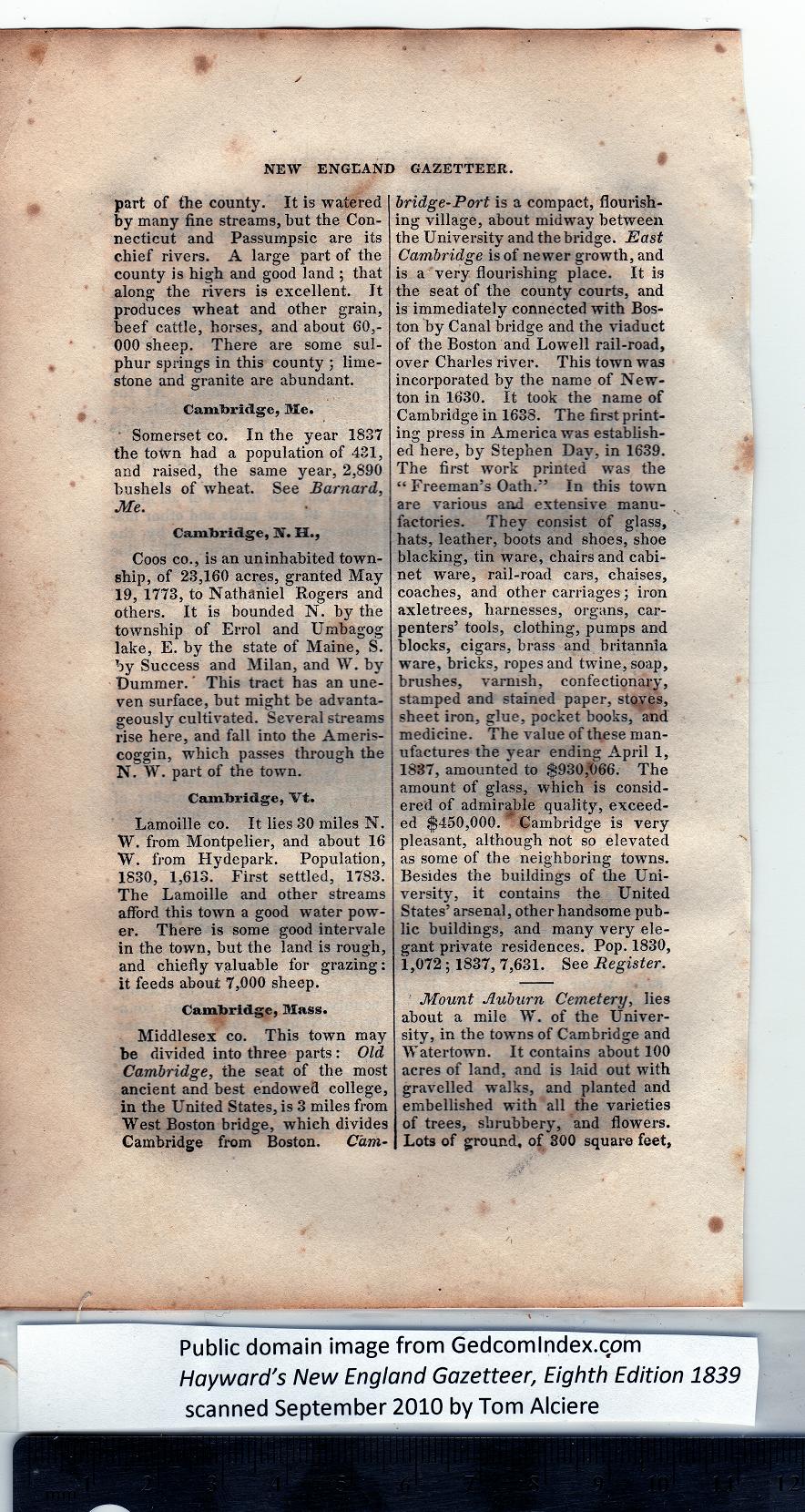|
part of the county. It is watered
by many fine streams, but the Con-
necticut and Passumpsic are its
chief rivers. A large part of the
county is high and good land ; that
along the rivers is excellent. It
produces wheat and other grain,
beef cattle, horses, and about 60,-
000 sheep. There are some sul-
phur springs in this county ; lime-
stone and granite are abundant.
Cambridge, Me.
' Somerset co. In the year 1837
tbe town had a population of 431,
and raised, the same year, 2,890
bushels of wheat. See Barnard,
Me.
Cambridge, N. H.,
Coos co., is an uninhabited town-
ship, of 23,160 acres, granted May
19, 1773, to Nathaniel Rogers and
others. It is bounded N. by the
township of Errol and Umbagog
lake, E. by tbe state of Maine, S.
by Success and Milan, and W. by
Dummer.' This tract has an une-
ven surface, but might be advanta-
geously cultivated. Several streams
rise here, and fall into the Ameris-
coggin, which passes through the
N. W. part of the town.
Cambridge, Vt.
Lamoille co. It lies 30 miles N.
W. from Montpelier, and about 16
W. from Hydepark. Population,
1830, 1,613. First settled, 1783.
The Lamoille and other streams
afford this town a good water pow-
er. There is some good intervale
in the town, hut the land is rough,
and chiefly valuable for grazing:
it feeds about 7,000 sheep.
Cambridge, Mass.
Middlesex co. This town may
be divided into three parts: Old |
Cambridge, the seat of the most
ancient and best endowed college,
in the United States, is 3 miles from
West Boston bridge, which divides
Cambridge from Boston. Cam-
bridge’Port is a compact, flourish-
ing village, about midway between
the University and the bridge. East
Cambridge is of newer growth, and
is a very flourishing place. It is
the seat of the county courts, and
is immediately connected with Bos-
ton by Canal bridge and the viaduct
of tbe Boston and Lowell rail-road,
over Charles river. This town was
incorporated by the name of New-
ton in 1630. It took the name of
Cambridge in 1638. The first print-
ing press in America was establish-
ed here, by Stephen Day, in 1639.
The first work printed was the
“ Freeman’s Oath.” In this town
are various and extensive manu-
factories. They consist of glass,
hats, leather, boots and shoes, shoe
blacking, tin ware, chairs and cabi-
net ware, rail-road cars, chaises,
coaches, and other carriages; iron
axletrees, harnesses, organs, car-
penters’ tools, clothing, pumps and
blocks, cigars, brass and britannia
ware, bricks, ropes and twine, soap,
brushes, varnish, confectionary,
stamped and stained paper, stoves,
sheet iron, glue, pocket books, and
medicine. The value of these man-
ufactures the year ending April 1,
1837, amounted to $930,066. The
amount of glass, which is consid-
ered of admirable quality, exceed-
ed $450,000. # Cambridge is very
pleasant, although not so elevated
as some of the neighboring towns.
Besides the buildings of the Uni-
versity, it contains the United
States’ arsenal, other handsome pub-
lic buildings, and many very ele-
gant private residences. Pop. 1830,
1,072 ; 1837, 7,631. See Register.
Mount Auburn Cemetery, lies
about a mile W. of the Univer-
sity, in the towns of Cambridge and
Watertown. It contains about 100
acres of land, and is laid out with
gravelled walks, and planted and
embellished with all the varieties
of trees, shrubbery, and flowers.
Lots of ground, of 300 square feet, |
